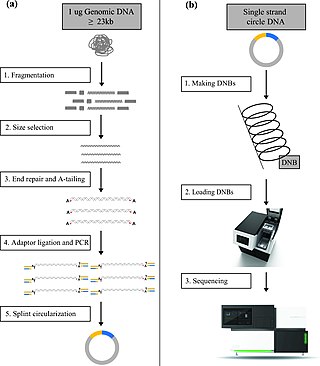Format
Initially the BED format did not have any official specification. Instead, the description provided by the UCSC Genome Browser [3] has been widely used as a reference.
A formal BED specification [4] was published in 2021 [5] under the auspices of the Global Alliance for Genomics and Health.
Description
A BED file consists of a minimum of three columns to which nine optional columns can be added for a total of twelve columns. The first three columns contain the names of chromosomes or scaffolds, the start, and the end coordinates of the sequences considered. The next nine columns contain annotations related to these sequences. These columns must be separated by spaces or tabs, the latter being recommended for reasons of compatibility between programs. [6] Each row of a file must have the same number of columns. The order of the columns must be respected: if columns of high numbers are used, the columns of intermediate numbers must be filled in.
| Column number | Title | Definition |
|---|---|---|
| 1 | chrom | Chromosome (e.g. chr3, chrY, chr2_random) or scaffold (e.g. scaffold10671) name |
| 2 | chromStart | Start coordinate on the chromosome or scaffold for the sequence considered (the first base on the chromosome is numbered 0 i.e. the number is zero-based) |
| 3 | chromEnd | End coordinate on the chromosome or scaffold for the sequence considered. This position is non-inclusive, unlike chromStart (the first base on the chromosome is numbered 1 i.e. the number is one-based). |
| 4 | name | Name of the line in the BED file |
| 5 | score | Score between 0 and 1000 |
| 6 | strand | DNA strand orientation (positive ["+"] or negative ["-"] or "." if no strand) |
| 7 | thickStart | Starting coordinate from which the annotation is displayed in a thicker way on a graphical representation (e.g.: the start codon of a gene) |
| 8 | thickEnd | End coordinates from which the annotation is no longer displayed in a thicker way on a graphical representation (e.g.: the stop codon of a gene) |
| 9 | itemRgb | RGB value in the form R,G,B (e.g. 255,0,0) determining the display color of the annotation contained in the BED file |
| 10 | blockCount | Number of blocks (e.g. exons) on the line of the BED file |
| 11 | blockSizes | List of values separated by commas corresponding to the size of the blocks (the number of values must correspond to that of the "blockCount") |
| 12 | blockStarts | List of values separated by commas corresponding to the starting coordinates of the blocks, coordinates calculated relative to those present in the chromStart column (the number of values must correspond to that of the "blockCount") |
Header
A BED file can optionally contain a header. However, there is no official description of the format of the header. It may contain one or more lines and be signified by different words or symbols, [6] depending on its functional role or simply descriptive. Thus, a header line can begin with these words or symbol:
- "browser": functional header used by the UCSC Genome Browser to set options related to it,
- "track": functional header used by genome browsers to specify display options related to it,
- "#": descriptive header to add comments such as the name of each column.
Coordinate system
Unlike the coordinate system used by other standards such as GFF, the system used by the BED format is zero-based for the coordinate start and one-based for the coordinate end. [6] Thus, the nucleotide with the coordinate 1 in a genome will have a value of 0 in column 2 and a value of 1 in column 3.
A thousand-base BED interval with the following start and end:
chr7 0 1000
would convert to the following 1-based "human" genome coordinates, as used by a genome browser such as UCSC:
chr7 1 1000
This choice is justified by the method of calculating the lengths of the genomic regions considered, this calculation being based on the simple subtraction of the end coordinates (column 3) by those of the start (column 2): . When the coordinate system is based on the use of 1 to designate the first position, the calculation becomes slightly more complex: . This slight difference can have a relatively large impact in terms of computation time when data sets with several thousand to hundreds of thousands of lines are used.
Alternatively, we can view both coordinates as zero-based, where the end position is non-inclusive. In other words, the zero-based end position denotes the index of the first position after the feature. For the example above, the zero-based end position of 1000 marks the first position after the feature including positions 0 through 999.
Examples
Here is a minimal example:
chr7 127471196 127472363 chr7 127472363 127473530 chr7 127473530 127474697
Here is a typical example with nine columns from the UCSC Genome Browser. The first three lines are settings for the UCSC Genome Browser and are unrelated to the data specified in BED format:
browser position chr7:127471196-127495720 browser hide all track name="ItemRGBDemo" description="Item RGB demonstration" visibility=2 itemRgb="On" chr7 127471196 127472363 Pos1 0 + 127471196 127472363 255,0,0 chr7 127472363 127473530 Pos2 0 + 127472363 127473530 255,0,0 chr7 127473530 127474697 Pos3 0 + 127473530 127474697 255,0,0 chr7 127474697 127475864 Pos4 0 + 127474697 127475864 255,0,0 chr7 127475864 127477031 Neg1 0 - 127475864 127477031 0,0,255 chr7 127477031 127478198 Neg2 0 - 127477031 127478198 0,0,255 chr7 127478198 127479365 Neg3 0 - 127478198 127479365 0,0,255 chr7 127479365 127480532 Pos5 0 + 127479365 127480532 255,0,0 chr7 127480532 127481699 Neg4 0 - 127480532 127481699 0,0,255








